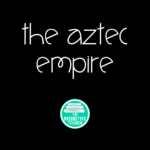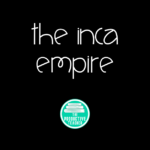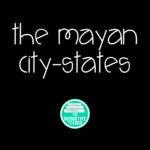Want to get back to the overview of the 1200 – 1450 CE section?
1200 – 1450 CE Overview
AP WORLD HISTORY HOMEPAGE
This post has everything you need to know about the early civilizations in the Americas for the AP World History test. Check out the Google Slides to learn more about the Aztecs, also known as the Mexica, the Incas, the Chaco, and Cahokia.
The Aztecs
The Aztecs were a remarkable Mesoamerican civilization that thrived in what is now central Mexico between the 14th and 16th centuries. Known for their complex society, advanced culture, and sophisticated urban centers, the Aztecs have left an indelible mark on the Americas.
The Aztecs, originally known as the Mexica, were a nomadic group that migrated to the Valley of Mexico in the 13th century. There, they settled on the island of Lake Texcoco and established the city of Tenochtitlan. This marked the beginning of the Aztec civilization. Over time, they formed alliances and absorbed elements of the surrounding cultures, including the Toltecs.
The Aztec society was highly structured and hierarchical. At the top was the emperor, or Huey Tlatoani, who held both political and religious authority. Beneath him were nobles, priests, and commoners. Slavery was practiced, and captives from warfare often became slaves.
Religion was central to Aztec life. They practiced a polytheistic belief system, with gods and goddesses for various aspects of life and nature. Human sacrifice was a key religious practice, with captives from warfare offered as sacrifices to appease the gods and maintain cosmic balance.
The Aztecs developed advanced agricultural techniques, including using chinampas, artificial islands in lake beds, to cultivate crops. They also built an extensive system of canals and aqueducts for irrigation and transportation.
Tenochtitlan, the Aztec capital, was one of the most impressive urban centers of the time. It featured monumental architecture, including step pyramids and temples. The city was interconnected by causeways and canals, showcasing their engineering and urban planning skills.
In 1519, the Spanish conquistador, Hernán Cortés, arrived, leading to a period of conflict and ultimately the fall of Tenochtitlan in 1521. Cortés defeated the Aztecs using several tactics. First, he formed alliances with various indigenous groups hostile to the Aztecs. These allies provided him with essential information, supplies, and additional warriors. Also, he had superior weaponry and technology, including horses, steel swords, firearms, and armor, which gave them a significant advantage in combat. The Aztecs, on the other hand, primarily used obsidian weapons and had limited experience with firearms and mounted soldiers. Finally, the Spanish carried smallpox, which devastated the Aztec population.
Social
Hierarchy: The Aztec society was hierarchical. At the top was the emperor, followed by nobles, priests, and commoners. Slavery was also practiced.
Religion: The Aztecs had a polytheistic religion with gods like Huitzilopochtli and Quetzalcoatl. Human sacrifices were a central religious practice.
Family Structure: Aztec families were typically extended, with multiple generations living together. Kinship and family ties were important.
Political
Government: The Aztec Empire was a military empire, ruled by an emperor known as the Huey Tlatoani. The empire was organized into provinces governed by regional leaders.
Tribute System: The Aztecs collected tribute from subject territories, which contributed to their wealth and power. When they conquered an area, the people would have to provide labor and goods to the empire.
Legal System: Laws in Aztec society were based on customary practices, and there were clear legal codes for various offenses.
Interactions with the Environment
Agriculture: The Aztecs practiced advanced agriculture, including the use of chinampas, artificial islands on lake beds, to grow crops like maize and beans.
Engineering: They built complex systems of canals, causeways, and aqueducts to manage water resources and transport goods.
Urban Planning: Tenochtitlan, the capital, was a well-planned city on an island with temples, palaces, and markets. The city was interconnected by causeways.
Culture
Language: The Aztecs spoke Nahuatl. Their writing system included pictograms and symbols.
Art and Architecture: Aztecs were known for their intricate art, including codices (books), pottery, and sculptures. Their architecture featured step pyramids and temples.
Calendar: The Aztecs had a complex calendar system, including a 260-day ritual calendar and a 365-day solar calendar.
Religion: Aztec religion was polytheistic, with many gods and goddesses. Central to their belief system was the need to appease these deities through rituals and human sacrifices to maintain cosmic balance and ensure the well-being of their society.
Economics
Trade: The Aztecs engaged in long-distance trade, including cacao beans and obsidian, using a barter system. They had a market economy with the Tlatelolco market in Tenochtitlan being one of the largest.
Tribute: Tribute from subject regions, including goods and labor, contributed to the Aztec economy.
Agriculture: Agriculture was a cornerstone of the economy, with the chinampas system allowing for the cultivation of crops.
Technology
Astronomy: Aztecs had an understanding of astronomy and a calendar system. They tracked celestial events, such as solar eclipses.
Metallurgy: They worked with various metals, including gold and silver, to create ornaments and jewelry.
Medicine: Aztecs had an understanding of herbal medicine and practiced surgery, including trepanation.
Math: The Aztecs had a shell-like symbol, which represented zero or an empty space in their numerical notation.
Chinampas
Chinampas are a unique Mesoamerican agricultural system that originated with the Aztecs in ancient Mexico. They are artificial islands or raised fields created in shallow lake beds, primarily in the region of the Valley of Mexico. Chinampas are constructed by dredging nutrient-rich mud and aquatic vegetation from the lake bottom to build up a fertile and productive growing area.
Artificial Islands: Chinampas consist of rectangular or square plots of arable land, separated by canals. These plots are created by weaving together sticks and reeds, which are then layered with mud and organic material.
Irrigation: The canals between chinampas provide a constant source of water for irrigation, allowing for year-round cultivation. This is particularly important in regions with a distinct dry and wet season.
Fertility: The mud and organic matter dredged from the lake bed are highly fertile, making chinampas incredibly productive for agriculture. Crops like maize, beans, squash, and various vegetables could be grown on these fields.
Sustainability: Chinampas are often cited as an early example of sustainable agriculture. They make efficient use of limited land resources and minimize soil erosion. Additionally, the aquatic environment of the canals provides habitat for fish and waterfowl, enhancing biodiversity.
Historical Significance: Chinampas were a fundamental part of Aztec agriculture, providing food for the growing population of the capital city of Tenochtitlan and its surroundings. The system played a significant role in the success and wealth of the Aztec Empire.
Aztec Education
Noble Education: The highest level of education was reserved for the nobility, the upper echelons of Aztec society. Noble children received a comprehensive education that included training in history, astronomy, theology, art, and combat skills. This education was typically provided by tutors and elders within families.
Commoner Education: Commoner children received a more practical education, which focused on the skills and knowledge needed for their roles in society. This education often included learning essential trades, agricultural techniques, and skills for everyday life.
Priestly Education: The Aztecs had a specialized class of priests who received a rigorous religious education. They were trained in Aztec religious beliefs, rituals, and the calendar system, which played a central role in religious ceremonies.
Calpulli Education: The calpulli was a social and political unit in Aztec society. Some education took place within the calpulli, where individuals learned about community customs, traditions, and responsibilities.
Oral Tradition: Much of Aztec knowledge and history was passed down through oral tradition. Elders and community members were responsible for teaching the next generation through storytelling, recitation, and oral histories.
Calpulli
The Aztec calpulli was a fundamental social and political unit in Aztec society, especially during the height of the Aztec Empire in the 15th and early 16th centuries. The term “calpulli” can be translated as “big house” or “neighborhood” in Nahuatl, the Aztec language. Calpullis were a crucial aspect of Aztec governance and community organization.
Local Governance: Calpullis were primarily local administrative units, akin to neighborhoods or small communities. Each calpulli was responsible for governing its own affairs, including issues related to land, resources, and local justice.
Land Ownership: Calpullis collectively owned and managed land and resources within their territories. This land was used for agriculture, and the produce was typically distributed among the members of the calpulli.
Tribute Collection: Calpullis were responsible for collecting tribute, or taxes, from their members to contribute to the central government. This tribute often included agricultural products, textiles, and other goods.
Social and Cultural Functions: Calpullis played a role in preserving and transmitting cultural traditions, customs, and knowledge within the community. They often organized religious ceremonies, festivals, and other communal activities within the calpulli.
Social Structure: Calpullis were organized hierarchically. Each calpulli had a leader, known as the “calpullec,” who represented the group in dealings with the central government. Calpullis were also divided into smaller kinship groups.
Economic Activities: In addition to agriculture, calpullis engaged in various economic activities, including craft production and trade. They often specialized in specific trades or crafts.
Community and Solidarity: Calpullis fostered a sense of community and solidarity among their members. People in the same calpulli shared common social bonds, and mutual support was a defining feature of these groups.
Relevance in Aztec Hierarchy: Calpullis existed within a hierarchical structure. At the top of the hierarchy was the central government of the Aztec Empire, led by the emperor. Below the central government were regional and provincial levels of governance, with calpullis forming the grassroots level of administration.
Kinship Ties: Many calpullis were based on kinship ties, with extended families forming the core of these communities. This allowed for close social and familial connections within the calpulli.
Pyramid of the Sun
The Pyramid of the Sun is one of the most iconic and significant structures in Mesoamerican archaeology. Located at the ancient city of Teotihuacan in present-day Mexico, this colossal pyramid stands as a testament to the architectural and engineering prowess of the ancient Mesoamerican civilization. The Pyramid of the Sun is the third-largest pyramid in the world, towering at approximately 216 feet in height. It is composed of a series of stepped layers, leading to a flat, rectangular platform at the top.
The Inca Empire
The Inca Empire, known as Tawantinsuyu in its native Quechua language, was one of the most remarkable and sophisticated civilizations in pre-Columbian America. Emerging in the 15th century in the highlands of what is now Peru, the Incas created a vast and organized state that stretched from present-day Colombia to Chile, encompassing a wide range of ecological zones, from the Andes Mountains to the coastal deserts and the Amazon rainforest.
The Inca Empire was characterized by its highly centralized and hierarchical political structure. At the pinnacle of power was the Sapa Inca, who was not just a political leader but also considered the divine “Child of the Sun.” Beneath the Sapa Inca were nobles and officials who administered the empire’s various regions. The empire was divided into provinces, each governed by a provincial governor appointed by the central authority. This centralized control allowed for efficient resource allocation and governance.
The Inca economy was primarily agrarian, with an emphasis on terraced agriculture. The Incas constructed extensive agricultural terraces to grow staple crops like maize, potatoes, and quinoa, as well as various vegetables. The state played a pivotal role in resource distribution, organizing labor through the “mit’a” system, which required citizens to contribute to state projects, such as infrastructure and agriculture. Trade networks crisscrossed the empire, with various regions producing distinct goods for exchange.
The Inca civilization is celebrated for its remarkable architectural achievements. They built intricate stone structures, such as the renowned city of Cusco and the mystical Machu Picchu, showcasing their mastery of stonemasonry. The Incas were skilled weavers, producing finely crafted textiles using cotton and alpaca or llama wool. Their textiles were both practical and ceremonial, featuring vibrant colors and complex patterns.
Inca religion revolved around the worship of various gods, with Inti, the sun god, holding a central role. The Incas conducted religious ceremonies and rituals, often involving offerings and sacrifices, both of animals and, on rare occasions, humans. The Festival of the Sun (Inti Raymi) was a significant religious event.
One of the most impressive aspects of the Inca civilization was their road system, known as the Qhapaq Ñan. This intricate network of roads and suspension bridges allowed for efficient communication, trade, and the rapid movement of troops throughout the empire.
Social
Social Hierarchy: Inca society was highly stratified. At the top was the Sapa Inca, the emperor, followed by nobility, bureaucrats, priests, and commoners. Slavery existed but was not as pervasive as in some other civilizations.
Ayllu System: The Inca social structure was organized around ayllus, or clans. Ayllus were responsible for land cultivation and communal labor, fostering a sense of community.
Gender Roles: Gender roles were well-defined in the patriarchal society, with men typically engaged in farming and warfare, while women were responsible for domestic tasks and textile production. Women had certain rights and privileges but were generally subordinate.
Political
Centralized Authority: The Inca Empire was characterized by strong centralized authority. The Sapa Inca held absolute power, and governors were appointed to oversee provinces.
Road System: The Inca Empire established an extensive network of roads and bridges, known as the Qhapaq Ñan, which facilitated communication and allowed for the rapid movement of troops and goods.
Territorial Expansion: The Incas expanded their territory through conquest and diplomacy, creating one of the largest pre-Columbian empires in the Americas. They were more accepting of conquered people than Aztecs.
Interactions with the Environment
Agriculture: The Incas practiced terraced agriculture, cultivating crops such as maize, potatoes, quinoa, and more in the challenging Andean environment.
Irrigation: They built sophisticated irrigation systems, including canals and terraced fields, to maximize agricultural productivity in the mountainous terrain.
Natural Resources: The Incas exploited various natural resources, including precious metals like gold and silver, which held great religious and aesthetic value.
Culture
Religion: They were polytheistic. They sometimes used human sacrifices, but more often used animals. They would often adopt religious practices of the groups they conquered. Inti Raymi, the Festival of the Sun, was one of the most important religious events in the Inca calendar.
Oral Tradition: The Incas did not have a written language but relied on an oral tradition to convey their history and culture.
Textiles: Inca weavers were renowned for their intricate textiles, which featured vibrant colors and complex patterns. Textiles served both practical and ceremonial purposes.
Metalwork: The Incas created various metal objects, including gold and silver ornaments, as well as utilitarian items like tools and weapons.
Economics
Agricultural Surpluses: Inca agriculture produced surpluses, which were redistributed by the state to support the population and sustain the empire.
Trade: The Inca Empire had an extensive trading network that spanned a vast territory, from present-day Ecuador in the north to Chile and Argentina in the south. They traded surplus agricultural products, textiles, gold, silver, and salt.
Labor System: The Inca state organized labor through the mit’a system, requiring citizens to contribute to state projects, including infrastructure and agriculture.
Technology
Terracing: Inca terracing techniques allowed for the cultivation of crops in the rugged Andean terrain.
Stonemasonry: Inca stonemasons were skilled at fitting massive stones together without the use of mortar, creating some of the most impressive stone structures in the world.
Road Engineering: The Inca road system was a remarkable feat of engineering, incorporating suspension bridges and paved highways.
Quipu: They used quipus, a system of knotted cords, for record-keeping and communication. Quipus contained information on various subjects, including census data and tribute collection.
In 1532, the Spanish conquistador Francisco Pizarro and his small army arrived in the Inca heartland. The Spanish exploited internal divisions and political tensions within the Inca Empire to their advantage. Pizarro captured the Inca ruler Atahualpa during a meeting and subsequently executed him, leaving the empire in a state of chaos and leadership vacuum. This event, known as the “Capture of Atahualpa,” was a severe blow to the Inca civilization. Over the next few decades, the Spanish continued to advance and conquer Inca territories, dismantling the empire. The arrival of the Spanish also introduced deadly diseases to which the indigenous population had no immunity. Smallpox, measles, and other diseases decimated Inca society, causing widespread death and further destabilizing the empire.
Machu Picchu
Machu Picchu, often referred to as the “Lost City of the Incas,” is one of the most iconic and breathtaking archaeological sites in the world. Located high in the Andes Mountains of Peru, this ancient city was constructed during the height of the Inca Empire, believed to have been built in the 15th century. The site is renowned for its stunning architecture, with precisely cut stone blocks that fit together without mortar, and its remarkable terraced agricultural fields. Perched on a ridge overlooking the Urubamba Valley, Machu Picchu offers panoramic views of the surrounding mountains and lush green landscapes. Its purpose remains a subject of scholarly debate, but it is widely believed to have served as a royal estate or a ceremonial center.
Chaco Civilization
The Chaco civilization refers to a pre-Columbian civilization that thrived in the American Southwest, primarily in the Four Corners region of the United States, between approximately 850 AD and 1250 AD.
Chaco Canyon: The heart of the Chaco civilization was Chaco Canyon in present-day New Mexico. This site featured a complex of monumental buildings and kivas, and it served as the political, economic, and religious hub of the culture.
Puebloan Culture: The Chaco civilization was part of the broader Puebloan culture of the American Southwest, characterized by the construction of multi-story, adobe buildings and kivas (underground rooms) for ceremonial purposes.
Great Houses: Chaco Canyon is home to several remarkable “great houses,” including Pueblo Bonito and Chetro Ketl. These structures are characterized by their intricate masonry and the alignment of walls and openings with astronomical events.
Roads and Infrastructure: The Chacoans developed an extensive road system connecting their great houses and other outlying sites. These roads are believed to have served both practical and ceremonial purposes.
Agriculture and Irrigation: The Chacoans practiced agriculture in the arid region by using terraces and canals for irrigation, allowing them to cultivate maize, beans, and squash.
Trade and Turquoise: The Chaco civilization was involved in long-distance trade networks, which allowed them to acquire valuable resources such as turquoise, shells, and macaw feathers from distant regions.
Decline and Abandonment: The Chaco civilization reached its peak around the 11th century but began to decline in the 12th century. The reasons for this decline and the eventual abandonment of Chaco Canyon remain the subject of scholarly debate and may include factors such as environmental challenges, social changes, and resource depletion.
Mesa Verde
Mesa Verde is a national park located in the southwestern United States, in the state of Colorado. It is renowned for its exceptional archaeological sites, primarily the well-preserved cliff dwellings and pueblo villages of the Ancestral Puebloans, who inhabited the region from approximately 550 to 1300 AD. Mesa Verde, which means “green table” in Spanish, is named for the flat-topped mesas that dominate the landscape.
Cliff Dwellings: The park is famous for its cliff dwellings, which are multi-story stone structures built into natural alcoves in the canyon walls. These dwellings are some of the most elaborate and best-preserved examples of Ancestral Puebloan architecture in North America. Notable sites include Cliff Palace, Balcony House, and Spruce Tree House.
Pueblo Villages: In addition to the cliff dwellings, Mesa Verde contains a variety of surface pueblo villages, including the Long House and Step House. These villages provide insights into the daily life, agriculture, and culture of the Ancestral Puebloans.
Kivas: Kivas, underground ceremonial chambers, are found in various sites throughout Mesa Verde. They were important for religious and communal activities and continue to be a subject of study and intrigue.
Rock Art: The park features numerous examples of petroglyphs and pictographs created by the Ancestral Puebloans. These rock art sites provide glimpses into their spiritual and artistic expressions.
Ancestral Puebloans: The Ancestral Puebloans, also known as Anasazi, were the indigenous people who inhabited the region for centuries. They were skilled farmers, architects, and artisans, known for their intricate pottery and basketry.
Cahokia
The Cahokia was an ancient Native American city located in present-day Collinsville, Illinois, just across the Mississippi River from St. Louis, Missouri. Cahokia was the largest pre-Columbian city in North America and was part of the Mississippian culture, which thrived between approximately 800 AD and 1350 AD.
Mound Complex: Cahokia is most famous for its earthen mounds, which are arranged in a complex layout. The largest and most prominent of these mounds is known as Monk’s Mound, which stands at over 100 feet tall and covers more than 14 acres. Monk’s Mound served as the central platform for the city’s leadership and religious ceremonies.
Cahokia Woodhenge: Adjacent to Monk’s Mound is the Cahokia Woodhenge, a circle of wooden posts believed to have been used for solar and lunar observations, as well as for scheduling important agricultural and ceremonial events.
Mound 72: Mound 72 is another significant mound at Cahokia, known for its archaeological findings. Excavations at this site revealed numerous burials and ceremonial objects, including a burial of a man believed to be an important figure. The findings suggest complex burial and religious practices.
Population and Society: At its peak, Cahokia is estimated to have had a population of between 10,000 and 20,000 people. The society was characterized by a complex social structure, with a ruling elite and various classes of workers and artisans.
Agriculture: The people of Cahokia practiced maize agriculture, relying on a maize-based diet. They constructed extensive raised fields to cultivate maize and other crops, demonstrating advanced agricultural techniques.
Trade Networks: Cahokia had trade networks that extended across a wide geographic area. Materials such as copper, mica, shells, and pottery from distant regions have been found at the site, indicating the city’s role as a trade hub.
Decline: The reasons for Cahokia’s decline remain the subject of debate among archaeologists. Factors such as environmental changes, resource depletion, and social upheaval are considered possible contributors to the city’s decline.
Want to get back to the overview of the 1200 – 1450 CE section?








Leave a Reply